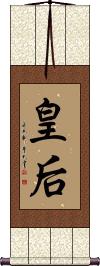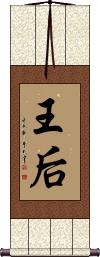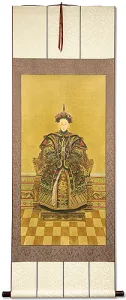Many custom options...
And formats...

Empress in Chinese / Japanese...
Buy an Empress calligraphy wall scroll here!
Personalize your custom “Empress” project by clicking the button next to your favorite “Empress” title below...
Empress
皇后 is the title of empress/emperess, the female form of the emperor.
皇后 is used in Chinese, Japanese Kanji, and old Korean Hanja.
While the emperor's reign was for life, if he died, his wife would hold his power. In this case, a woman was the ultimate ruler of the greater part of East Asia (now China) until her death and the succession of the emperor's firstborn son to lead the empire. Numerous times in various Chinese dynasties, an empress took power in this way.
The first character means emperor by itself.
The second character alone can mean “wife of an emperor or king” (the first character clarifies that we are talking about an empress and not a queen). It can also mean sovereign or last offspring, depending on context.
Note: In some books, this word is translated as queen. While only incorrect if you get technical (because an empress is theoretically a higher level than a queen), the meaning is very similar.
皇后 is sometimes used for the title of queen, but more technically, this is the wife of the emperor (a higher level than a queen).
Queen / Empress
Wife of the King
王后 is another way to write queen in Chinese, Japanese Kanji, and old Korean Hanja.
王后 is sometimes used for the title of empress.
The first character means “king,” and the second means “wife,” or a short form to say “wife of the king/emperor.” So this is literally “king's wife” or “emperor's wife.” Some will translate this as “queen consort.”
This in-stock artwork might be what you are looking for, and ships right away...
Empress Ancestor Of China
Print Wall Scroll
Discounted Blemished
Gallery Price: $200.00
Your Price: $79.88
Not the results for empress that you were looking for?
Below are some entries from our dictionary that may match your empress search...
| Characters If shown, 2nd row is Simp. Chinese |
Pronunciation Romanization |
Simple Dictionary Definition |
皇后 see styles |
huáng hòu huang2 hou4 huang hou kougou / kogo こうごう |
More info & calligraphy: Empressempress (consort); (surname) Kōgou empress |
葉卡捷琳娜 叶卡捷琳娜 see styles |
yè kǎ jié lín nà ye4 ka3 jie2 lin2 na4 yeh k`a chieh lin na yeh ka chieh lin na |
More info & calligraphy: Yekaterina |
后 see styles |
hòu hou4 hou kisai きさい |
empress; queen; (archaic) monarch; ruler (poetic term) empress (consort); queen (consort); (female given name) Kisaki |
嫄 see styles |
yuán yuan2 yüan |
name of an empress |
曌 see styles |
zhào zhao4 chao |
name invented for herself by Tang empress Wu Zetian 武則天|武则天[Wu3 Ze2 tian1] |
桐 see styles |
tóng tong2 t`ung tung kiri(p); kiri きり(P); キリ |
tree name (variously Paulownia, Firmiana or Aleurites) paulownia (Paulownia tomentosa); empress tree; foxglove tree; (surname, female given name) Hisa |
三后 see styles |
sankou / sanko さんこう |
Grand Empress Dowager, the Empress Dowager and the Empress Consort |
三宮 see styles |
mimiya みみや |
(rare) (See 三后) Grand Empress Dowager, the Empress Dowager and the Empress Consort; (surname) Mimiya |
中宮 see styles |
nakamiya なかみや |
(1) (See 三后) the Empress, the Empress Dowager and the Grand Empress Dowager; (2) emperor's second consort; (3) empress; palace of the empress; (4) building of a Shinto shrine built on middle ground; (5) (See 皇居) demesne of the imperial palace; (place-name, surname) Nakamiya |
乾陵 see styles |
qián líng qian2 ling2 ch`ien ling chien ling |
Qianling at Xianyang 咸陽市|咸阳市 in Shaanxi, burial site of third Tang emperor 高宗 and empress Wuzetian 武則天|武则天 |
亮闇 see styles |
ryouan / ryoan りょうあん |
court mourning (for the late emperor or empress); national mourning |
佛爺 佛爷 see styles |
fó ye fo2 ye5 fo yeh |
Buddha (term of respect for Sakyamuni 釋迦牟尼|释迦牟尼[Shi4 jia1 mou2 ni2]); His Holiness (refers to a Buddhist grandee); Buddha; God; emperor; in late Qing court, refers exclusively to Empress Dowager Cixi 慈禧太后[Ci2 xi3 tai4 hou4] |
儀宸 see styles |
gishin ぎしん |
empress dowager's home |
六宮 六宫 see styles |
liù gōng liu4 gong1 liu kung rokumiya ろくみや |
empress and imperial concubines or their residence (surname) Rokumiya |
内裏 see styles |
dairi だいり |
(1) imperial palace; (2) (abbreviation) (See 内裏雛) festival dolls representing the emperor and the empress; (place-name) Dairi |
冊立 册立 see styles |
cè lì ce4 li4 ts`e li tse li sakuritsu; sakuryuu / sakuritsu; sakuryu さくりつ; さくりゅう |
to confer a title on (an empress or a prince) (noun, transitive verb) imperial investiture; installation |
台臨 see styles |
tairin たいりん |
visit by the empress or the crown prince |
台覧 see styles |
tairan たいらん |
inspection by the empress or the crown prince |
后冠 see styles |
hòu guān hou4 guan1 hou kuan |
crown or tiara of a queen, empress or beauty pageant winner; first place in a women's competition |
后宮 see styles |
kouguu / kogu こうぐう |
(1) empress's palace; queen's palace; (2) empress; queen |
后座 see styles |
hòu zuò hou4 zuo4 hou tso |
empress's throne; (fig.) first place in a feminine competition |
哀家 see styles |
āi jiā ai1 jia1 ai chia |
I, me (self-referring by a widowed empress etc, used in historical novels and operas) |
国忌 see styles |
kokki こっき |
anniversary of the death of an emperor or empress |
国母 see styles |
kokubo こくぼ |
empress; empress dowager; (place-name, surname) Kokubo |
大宮 see styles |
oomiya おおみや |
(1) (honorific or respectful language) imperial palace; shrine; (2) Grand Empress Dowager; Empress Dowager; (3) woman of imperial lineage who has borne a child; (4) elderly woman of imperial lineage; (place-name, surname) Oomiya |
天后 see styles |
tiān hòu tian1 hou4 t`ien hou tien hou tenkou / tenko てんこう |
Tin Hau, Empress of Heaven, another name for the goddess Matsu 媽祖|妈祖[Ma1 zu3]; Tin Hau (Hong Kong area around the MTR station with same name) queen of heaven Queen of Heaven, v. 摩利支. |
太后 see styles |
tài hòu tai4 hou4 t`ai hou tai hou taikou / taiko たいこう |
Empress Dowager empress dowager; queen mother |
女帝 see styles |
jotei; nyotei / jote; nyote じょてい; にょてい |
empress |
女皇 see styles |
nǚ huáng nu:3 huang2 nü huang jokou / joko じょこう |
empress (See 女帝) empress; queen |
女院 see styles |
nyouin / nyoin にょういん |
(honorific or respectful language) (See 院・6) woman bestowed with the title "in" (usu. the empress, imperial princesses, etc.); (personal name) Nyouin |
Click here for more empress results from our dictionary
The following table may be helpful for those studying Chinese or Japanese...
| Title | Characters | Romaji (Romanized Japanese) | Various forms of Romanized Chinese | |
| Empress | 皇后 | kou gou / kougou / ko go | huáng hòu huang2 hou4 huang hou huanghou | |
| Queen Empress | 王后 | ou kou / oukou / o ko | wáng hòu / wang2 hou4 / wang hou / wanghou | |
Successful Chinese Character and Japanese Kanji calligraphy searches within the last few hours...






